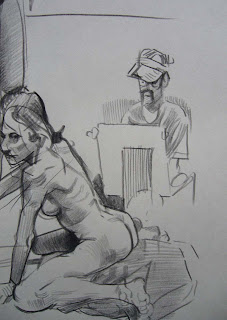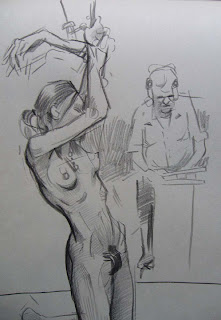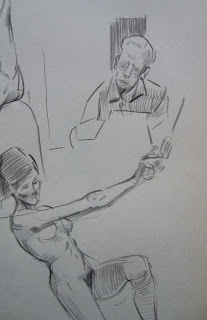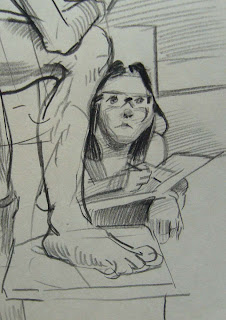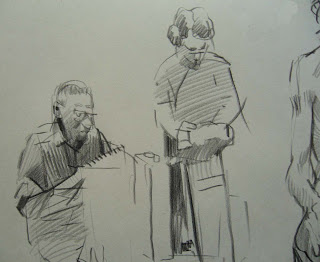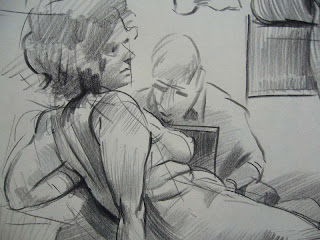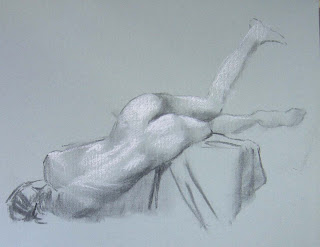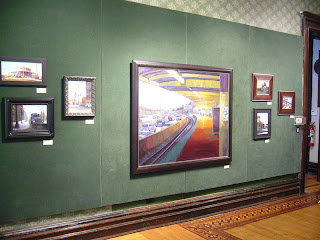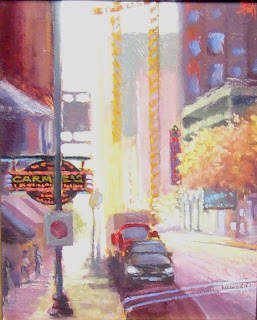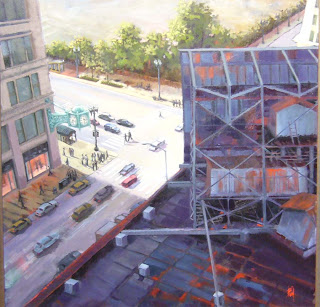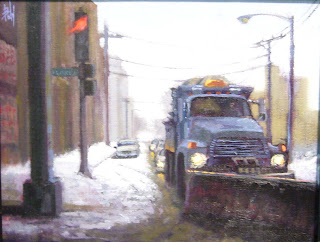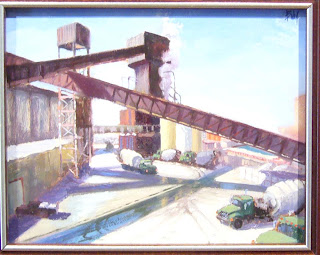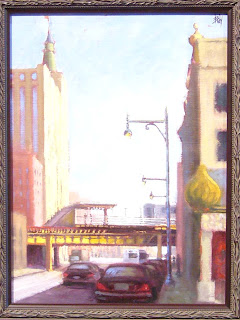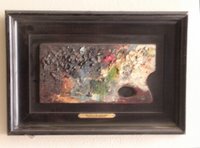Frank Hensley - A recollection
Frank Hensley - A Recollection by Rich Morrow
Frank Hensley was a rambler.
He spent the better part of his retirement years crisscrossing the country visiting friends and relatives, but mostly visiting museums and galleries, many of them on the west coast and in the southwest.
He was the Palette & Chisel's unofficial historian and he knew a lot about the early membership of the Academy, especially those artists who had moved west; not just the Taos painters Ufer, Hennings, and Higgins, but also a colony that established itself in Laguna Beach, CA and included more obscure painters like Hanson Puthuff. Frank sought out museums that had works by these artists and was on the look out for gallery shows that included them. He had an extensive collection of catalogs from these shows and others which featured artists from the golden age of American illustration. He would frequently bring these catalogs to Wednesday and Friday evening quick sketch sessions and it became a standing joke to ask him the exact dates of his next road trip, the implication being that we would break into his apartment and steal his catalog collection while he was out of town.
Frank was not born in a log cabin only because there were no logs in eastern Montana where his parents had moved and taken up homesteading. He was born in a sod house, however, and spent his early years there until he was sent off to school in a neighboring town. One can only imagine how hard the winters must have been living in a sod house in Montana!
After high school, Frank enlisted in the Army Air Corps and saw action in the Pacific theater during World War II. He described to me on several occasions his being assigned to a detail whose job was to clean up the crash site of an airplane that had exploded on takeoff. He told of the eerie and revolting experience of collecting body parts strewn along the runway. He expressed relief that the war was ended abruptly by the detonation of atomic weapons because, as he put it, neither he nor any of his mates in the squadron expected to return to the States alive.
After the war, Frank got work doing illustration in St. Louis for a brief time before moving on to Chicago where he spent the remaining 55 years of his life.
When he found out I was from St. Louis, the opening remark of every conversation we had would either be about St. Louis or about some P&C member who
had moved out west.
Frank spent his entire commercial career in Chicago as an illustrator at Leo Burnett. In the trade, he was what is known as "a wrist", an illustrator who can draw anything and everything on short notice. He also did magazine work including covers for American Legion Magazine. He was an accomplished pastelist who was never quite satisfied with his own work. I have seen more than one quick sketch model rescue a beautiful drawing of herself from the trash can where Frank had deposited it. He steadfastly avoided male models and always wanted to know the name of next week's model. I was delighted to have a little fun with him whenever the model had an androgynous name like Chris or Pat. Frank also rambled when he talked. Everything he said seemed to remind him of something else, so that a description of a painting with a horse in it might lead to a recollection of a horse he had ridden in a national park leading to a survey of national parks in the southwest followed by a comparison of the southwest climate to that of California leading to an observation of the preponderance of horses in the paintings of a certain California artist. Somehow, the conversation always seemed to come full circle. The tangents were all linked together with the conjunction "of course" which Frank employed in much the same way a cab driver leaves the rear end of his taxi sticking out into the middle lane while discharging a passenger in the curb lane so that he will have an open lane in which to drive away. The "of courses" were meant to keep you from getting a word in edgewise. Many people did not have the patience for these one sided conversations, but I found them to have an endearing quality and learned early on that I was going to be there awhile until he finished.
A perhaps apocryphal story along these lines involves a visit to one of Frank's favorite museums, Wauwatosa in Milwaukee. He attended an exhibition there with a colleague from the Academy and as they were leaving Milwaukee by car, the colleague asked Frank how he liked the exhibition. As the story goes, the colleague claims that Frank was still answering the question when they reached the Chicago city limits!
Frank was one of the longest extant members of the P&C at the time of his ~ death. He joined the Academy some time in the 1950s. He developed bone marrow cancer about the year 2003 and I recall him looking very ghostly at that time. With chemotherapy, he seemed to regain his old vigor and coloration and as soon as he felt well enough, headed back out on the road. Frank preferred Motel 6 for lodging as he logged the long miles to favorite destinations like Bartlesville OK, or Sedona AZ, or Laguna Beach CA.
He also liked to visit former P&C president Diana Farran's studio in Greenville MI and last summer showed up unannounced at the back door of my little country house in New Salem IL. I gave him a tour of the house (as much a tour as a five room house permits) and as we walked out onto the front porch, he abruptly bid me goodbye and, despite my protests, drove away.
He was at my place all of ten minutes and after he had gone, I thought to myself: "Now isn't that just like Frank?"








